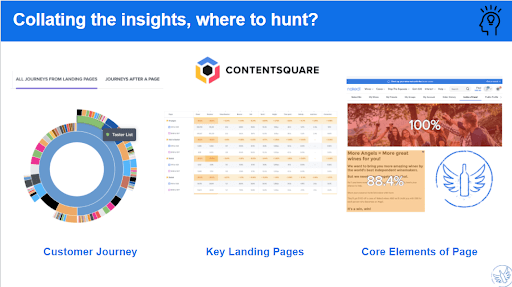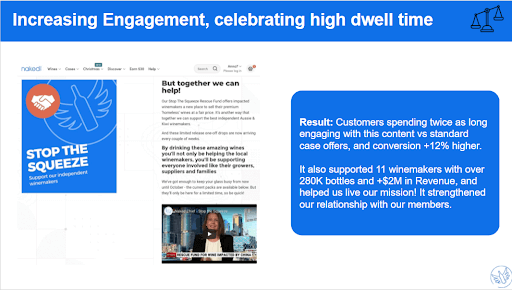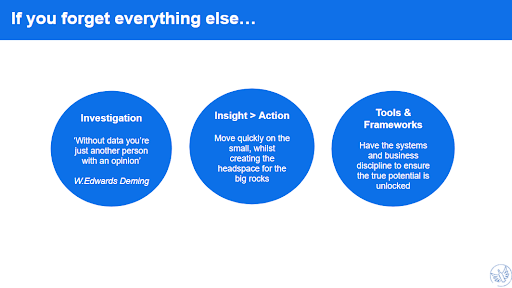
Take a product tour
Get to grips with Contentsquare fundamentals with this 6 minute product tour.

Naked Wines use a clear 3-step approach to improve their customer journeys and optimize their digital customer experiences using Contentsquare Insights:
Naked Wines discovered that data investigation was a great balance between the time spent going through data and the overall return on investment. They zeroed in on three lenses, which captured the essence of customer experience and provided them with a clear picture of where they should focus their efforts.

Anna shared 3 examples of how her team improved their customer experience – through customer journeys, key landing pages, and increasing engagement.
Example 1: Customer Journeys
For new customer journeys, Anna’s team discovered that the more pages new customers visited, the lower their conversion rate. The reason? Simply because these new customers tended to get lost in their website, and were not at the stage that Naked Wines needed to tell them their whole story. Instead, the company wanted to keep them in their attractive front introductory offer.

A quick insight they turned over almost overnight was simplifying their navigation menu. Instead of showing new visitors different wine selections upfront, new visitors will be directed to the introductory offer to prevent them from getting lost on-site. On the small chance that they navigate away, another menu is reintroduced to convert them back to the introductory offer.
As a result, users are kept in the life cycle stage where they belong as new customers. Over the last few months, this simple change resulted in a 5% increase in conversion.
Example 2: Key Landing Pages
After a user successfully becomes a member with Naked Wines, the next stage in the customer journey is to drive lifetime value. They identified a key landing page that was one of the top 10 most visited pages, but had a suboptimal conversion rate. Immediate action was taken to divert traffic away from the page. The team fixed the URL until they had time to conduct a site triage to figure out the reason behind the low conversion rates.

Using Contentsquare’s zone-based heatmapping tool, the team found several minor changes that needed to be made to the navigation and naming. However, what really stood out was the impact of the products that were out-of-stock.
Naked wines used Contentsquare’s data to identify the exact dollar size of impact for every person that hovered over out-of-stock products but didn’t click to convert. Working with independent winemakers with a slower production pace, also means that restocking usually takes about 6 months. Hence, a different solution was needed.
To fix this issue, Naked Wines launched a new pre-order function for products with a loyal following. While it seemed like a fairly intuitive and easy thing to carry out, Anna explained that the key ingredient was the data which showed a clear impact on revenue. This enabled her to present a business case to get more resources to solve this issue – one being a new member in the team to oversee the new pre-order function.
From there, Naked Wines launched their first major Christmas pre-order this December, which drove incremental growth and conversion on the core landing page.
Example 3: Increasing Customer Engagement
As a subscription company, it’s imperative that Naked Wines has continuous customer engagement and dwell time. Slowing down the customer on-site, viewing numerous pages, and is highly engaged with the content is important to share Naked Wines’ story and their unique value in disrupting the wine industry.
So having a top-down perspective of customer journeys, bounce rates, and content was crucial to leverage their campaigns.
One campaign Naked Wines wanted to share with their customers was ‘Stop the Squeeze’, a large fund that supported 11 of their independent winemakers greatly affected by China’s wine tariffs. The company bought approximately 280,000 of their bottles which generated over $2 million in revenue.

But how would they share it with their customers without compromising conversion rates? Throughout the 10-week campaign, Naked Wines reviewed elements with high dwell times, high float times, attractive parts of the page that were converted, etc. It helped them to understand where their story belonged in the navigation menu and ensured that customers were viewing content at a time where it would deepen their relationship with the company.
Their efforts paid off — customers were spending twice as long engaging with the campaign content compared to their standard case offers.
Take a product tour Get to grips with Contentsquare fundamentals with this 6 minute product tour.
With big data comes big responsibility. Having tools and systems in place to transact the data is important to continuously improve their customer experience.
Anna’s team has found the perfect blend of optimizing user experiences:
Naked Wines has democratized the data by having multiple functions in the company use Contentsquare’s digital experience analytics platform. With Contentsquare’s simple yet visual interface, any function can easily digest the data and insights from their site. This has moved the company to a more data-backed approach when assessing ideas systematically against the ease versus impact metric.
Being a global company, it’s critical that all global teams are heard. And by assessing all of their ideas using the same metric, the process is simplified, which helped to easily identify the biggest wins.
Streamlining the decision-making process has helped the company build out their strategic roadmap. This roadmap is shared across the company, where every employee can view the company’s priorities to enhance their customer experience.
